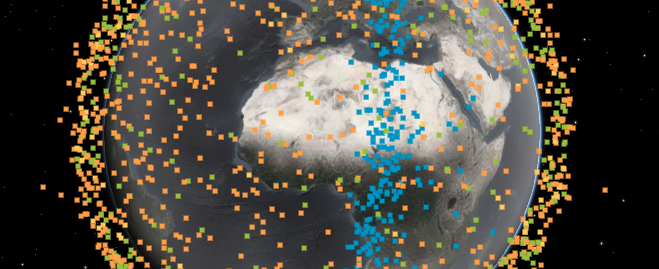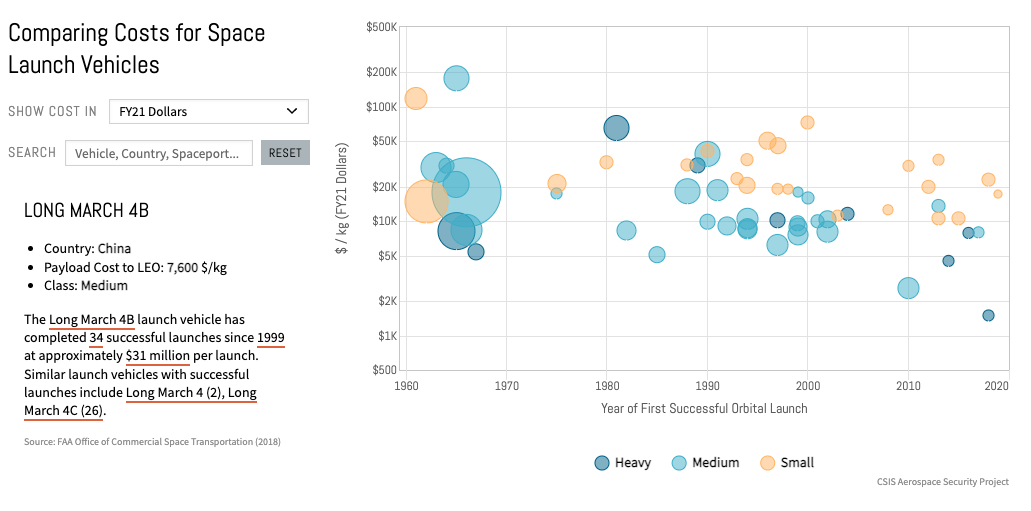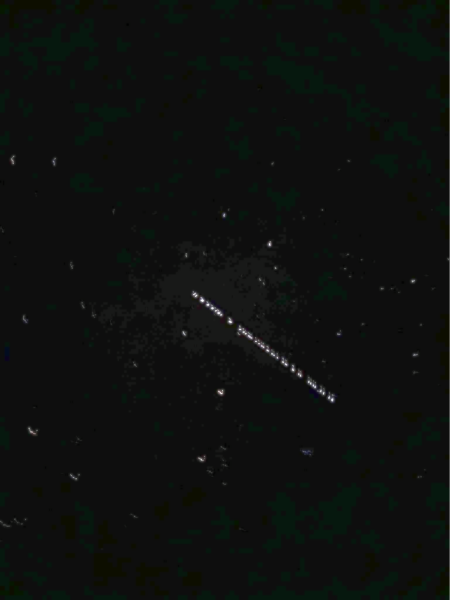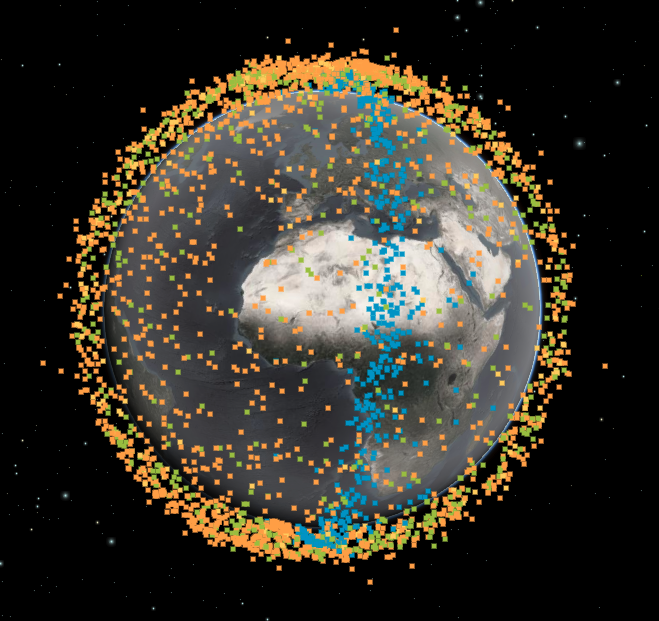
This is the third provocation in a three-part series on critical data infrastructure as part of an Open Data Institute (ODI) project: Power and Diplomacy in Data Ecosystems. These three initial provocations help to demonstrate how we have begun to explore topics related to international data ecosystems, physical infrastructure and dynamics of power. All three provocations will be probed and challenged through a roundtable with key researchers as well as through a joint project with the ODI’s Data as Culture programme.In our first provocation we surveyed the land-based infrastructure that is integral to the functioning of the internet. Next we delved beneath the seas to fathom the growing privatisation of the cables that carry so much of the world’s data. In this our final provocation of the series, we turn our gaze upwards, beyond the cloud(s), to consider the increasing role that satellites play in collecting and transferring data.
Recent advances in satellite and rocket technologies, coupled with insatiable appetites for greater volumes of data at increased speeds, have added rocket fuel to the so-called ‘billionaires space race’. And it's not just the billionaires who are jostling for position; private companies are also locked in competition to be the primary providers in the strategically significant realm of space-based services. On a more zoomed-out, existential level, Gärbedo, Marzecova and Vikström suggest that this renewed focus on satellites is “paramount to the expansion of the technosphere”. In other words, the next inevitable step by humans in the development of an emerging global paradigm is characterised by our actions and the technologies we have created – for better and worse.
But what does this colonisation of space actually mean and why is it relevant to data? Historically, the advantages afforded to first and early adopters of new technologies are transformative. However, this can simultaneously exacerbate market concentrations, including the perpetuation of existing power dynamics between certain actors and the establishment of new ones.
In this provocation, we look to shed some light on the data-related implications of satellite technologies. We will cover both the opportunities they present and some of the associated drawbacks. We start with a brief contextualisation of satellites and their relationship with data, before going on to explain their current uses and related significance. This leads us to ask some difficult questions and we very much welcome your thoughts and input to help us answer them.
Why satellites? Why now?
As noted in the second provocation, the vast majority of data transmission still occurs via submarine cables. However, in recent decades more attention has been paid to the role that satellites might play in meeting an ever-increasing demand for greater connectivity. This is particularly relevant in parts of the world where the provision of broadband is more challenging. Fast and reliable data transfers are critical to the functioning of modern economies and societies, where real-time data has become the standard to which countries and companies now strive.
Until recently, providing such wireless connectivity by satellites was largely considered unviable, given the high costs associated with sending objects into space. As a result, it has been common for larger and more complex satellites capable of performing multiple functions including sensing and imaging, on top of communication, to be favoured. These satellites were (and continue to be) situated in what is called geostationary (or geosynchronous) orbit some ~36,000km from Earth’s equator. However the disadvantages of such fixed, multifunctional satellites include that their coverage is limited to a specific area; spatial resolution can be lower; communication costs and times can be greater. Many of these early satellites were commissioned as a result of the competition between the Cold War superpowers, who invested vast sums in both enabling research and putting the satellites into space.

This setup was sufficient for the communication needs and preferences in the second half of the 20th century. However, the reduction in costs associated with sending objects into space, coupled with ever-increasing appetites for real-time data have changed things quite significantly. Nowadays, much of the focus by both states and companies has shifted towards populating the skies with constellations of low Earth orbit (LEO) satellites in pursuit of reaching ever higher rates of online connectivity. Investment by private companies in satellites has been central to spurring this innovation, thus diversifying the services provided and applications enabled. At the same time, this diversification has contributed to a decentralisation of control and dependency on state-backed satellites, to a space in which commercial providers are now significant actors who command considerable power and influence.
The importance of satellites in modern society
Satellites are increasingly significant as a critical node in data infrastructure. A combination of what satellites are able to do and the currently limited pool of satellite owners should be seen as an acute example of critical data infrastructure that could be vulnerable to exploitation should owners choose to exert their power.
Data collection
Satellites have been transformative in helping us understand our world through the collection of data about the earth and its atmosphere (eg temperature, rainfall, wind speed etc.). These types of data have plenty of civilian applications, such as providing more accurate weather forecasts and helping people plan their journeys.
However, satellite data also has many more significant roles to play, particularly in helping to tackle the existential threat posed by climate change. Examples include the optimisation of commercial transportation to reduce emissions, and the direct measurement of global carbon emissions in order to hold companies and states accountable. Much of this data is made freely and openly available by satellite owners and operators.
Initiatives such as the European Union’s Copernicus Open Access Hub exemplify some of the collaborative efforts we have looked at as part of our project, where value is opened up to external actors through the provision of open data. Satellite data has also facilitated the monitoring of nuclear activity in countries such as Iran and North Korea, not just by other governments but also by journalists and investigative agencies. High-profile examples of this include the Airwars investigation of the ISIS prison break and the Guardian’s investigation into Uighur camps.
But we are also interested in exploring situations where well-intentioned efforts may lead to some actors gaining an advantage, whilst impacting negatively on others within data ecosystems. Images collected by satellites have helped fuel various types of competition between state and non-state actors, in which they have sought to exploit privileged access to data. Satellite data has also been used in innovative ways by investors to inform their stock market investments. This occurred at a time when access to satellite data was more limited and only available to those who had the means to pay, thus providing them with an information advantage. Even today, while access to satellite imagery has increased through government initiatives and free-to-use commercial mapping tools, there are considerable advantages to be had by those who have access to real-time data. This is particularly the case within market trading where even milliseconds can mean millions.
Data communication
The second significant function of satellites, which has increased their importance in the data infrastructure, is that they provide an alternative method to consistently provide high-speed broadband connections, particularly in parts of the world that are more difficult to reach.
In addition to the geographic rationale behind the recent renewed interest in satellite broadband, there is a much more pressing geopolitical need for this technology. The physical infrastructure underpinning data storage and transmission is inextricably political. This is also true of satellites, which can serve to provide states with an alternative, potentially more resilient means of providing broadband connectivity.
The use of low Earth orbit (LEO) broadband provider Starlink in Ukraine is a particularly pertinent illustration, as it has enabled Ukraine to maintain internet connectivity in the face of Russian aggression targeted specifically at the country’s telecommunications infrastructure. However, whilst cyberspace infrastructure may be less vulnerable to attack in times of conflict, the Ukrainian example has also raised concerns. Lack of funding meant that swathes of mobile satellite dishes used on the ground to connect to the orbiting Starlink satellites went offline. Then the providers of Starlink curtailed the use of its service ‘for offensive purposes’. This demonstrates the challenges that arise when power is concentrated in the hands of just one or two providers. In particular, the limitation on use ‘for offensive purposes’ raises questions about how private companies may begin exerting influence over what “offensive purposes” constitutes. Are companies, with their myriad business interests and relationships, the appropriate arbiters for such decisions?

Taiwan is another example of the shift towards low Earth orbit (LEO) broadband. In Taiwan's case there are concerns over its dependency on the subsea internet cables that connect to mainland China. As tensions continue to rise around access to advanced semiconductor chips, of which Taiwan is the most significant producer, these cables have been identified as potential targets for possible Chinese interference. Recently, Taiwan’s deputy minister for digital affairs, Herming Chiueh, suggested that Taiwan is currently viewing satellite broadband as a means to establish greater sovereignty over its internet connectivity. As evidenced by the current relationship between Starlink and Ukraine, this might be a misnomer. To speak in absolute terms belies the nature of power relationships, concentrations and distributions - particularly with regards to sovereignty in any form. Instead, in such cases as internet connectivity, it is perhaps more sensible to consider the extent to which sovereignty is distributed, or concentrated.
What’s missing from current debates and what’s the data angle?
Equitability of access
In Ukraine access to the internet has been restricted when this has conflicted with the commercial interests of the provider. This demonstrates both the power of the company operating the satellite and the dependency of states on these technologies. We are now having to answer very difficult questions about how these challenges can be mitigated.
Is it possible for access decisions to be adjudicated so that it doesn’t come down to the will of one person or company to determine where the lines are drawn around the “humanitarian” use of satellites? Should we be considering the use of regulation? Or standards? Perhaps there needs to be renewed discussion of a possible technology charter of principles, where consideration could be given to where it is responsible or imperative to provide access to the use of satellites and the data they collect.
Environmental sustainability
There’s growing evidence to suggest that the environmental concerns around the increased use of satellites might be well founded; there aren’t yet definitive conclusions on the extent to how bad things might get.
It also seems appropriate to consider whether any analysis has been conducted on the potential long-term environmental/economic cost if we pursue the current plans for multiple, replenishing LEO constellations. The current narrative is that satellites and rockets are more economically efficient and are bringing benefits that outweigh their costs. However, history has shown, as we have seen in the use of fossil fuels, that the innate tendency to focus efforts on modernisation comes at the expense of long-term damage to the environment. Is it possible that we may be facing the same situation with satellites? Are we currently favouring greater connectivity and faster data transfers over the future health of our planet?

Image: space debris recorded from just three satellite incidents: blue = destruction of Cosmos 1408 satellite by Russian anti-satellite weapon; green and yellow = collision between Russian Cosmos 2251 and US Iridium 33 spacecrafts; orange = destruction of Fengyun 1C satellite by Chinese anti-satellite missile.Could it be that data is such a prized commodity, that the competition between states and companies over connectivity could have significant consequences for the future of the planet. What alternatives are there? Do we really need multiple LEO constellations? Possibly not. Will we end up with multiple constellations? Probably yes. This is increasingly likely when we consider the national security angle and general trends towards a more realist approach to international relations in recent times. We are left asking what can be done and what would be ideal?
Privacy
Finally, what about people’s right to privacy? In her book, Privacy is Power Carissa Véliz raises the potential consequences of inconspicuous satellite surveillance as follows:
“Will Marshall and his team at Planet Labs already image the whole planet every single day through satellites. Now they’re trying to index all the objects in the world and make them searchable. Anyone could surveil you using their satellites. That they are allowed to do this work, and that they present it with no mention of privacy is very alarming. The sky should not be watching us” Carissa Véliz, Privacy is Power, p. 185
On its website, Planet Labs states:
“On average, Planet has 1700 images of every place on earth. This is an unprecedented dataset - we’re creating a global, near-daily stream of satellite imagery that can be fed into a variety of workflows for commercial and humanitarian applications, enabling an ecosystem of apps and services”.
It is important to note that Planet Labs makes no mention of ethical concerns or considerations that the company may or may not be factoring into its business operations. For example, what, if any, vetting practices are in place when considering clients or publishing data? Having answers to questions such as these is important, particularly when considering that while this data can be used to help save lives, it could also be used to facilitate ‘pull-backs’ or be used to prosecute asylum seekers.
There are clearly many ethical questions around the use of satellite imagery that need to be addressed. It would be worthwhile beginning this with a discussion of what is right, considering that it is unclear whether present legislation such as the GDPR applies in outer space, where satellites are in operation. Doing so can help inform broader debate on the unintended or unexpected consequences that can result when more data is made openly available
We would like to invite anyone interested in this topic to get in touch with the Power and Diplomacy in Data Ecosystems team, to respond to the questions raised by this provocation.
Resources
This provocation is the third and final in the series. For more materials on this subject, see our collaborative bibliography – a curated, living repository of books, reports, podcasts and research papers compiling some of the brilliant work by researchers across the globe who are investigating how data and digital technologies shape new geopolitical dynamics worldwide.